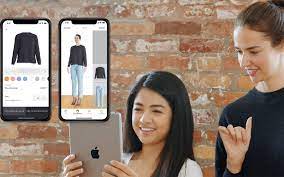How Augmented Reality Can Resolve Fit and Size Problems in Online Fashion Shopping

Finding the ideal size and fit when shopping online presents one of the largest obstacles for customers. However, this issue can now be solved efficiently because to developments in augmented reality (AR) technology. Your fashion e-commerce platform may offer virtual try-on experiences that will redefine how customers find and choose clothing by incorporating AR solutions. In this post, we'll look at how augmented reality can help with fit and size problems in the e-commerce world of fashion. Enhancing Virtual Try-On Experiences: Customers can virtually try on apparel using their cellphones or other devices with augmented reality. Fashion businesses may give customers an immersive experience that resembles the actual trying-on procedure by utilizing AR. Users may view the fit of clothing on their bodies in real-time, enabling them to choose the right size and fit before making a purchase. This takes the uncertainty out of it and lessens the possibility of returning products that don't fit. Accurate Sizing and Measurements: Customers can use augmented reality to determine their measurements with greater accuracy. Customers may use their devices to take exact measurements of their bodies using AR technology, assuring a more accurate selection of apparel sizes. By offering advice on measuring methods and making size suggestions based on these dimensions, you may improve fit and lessen the chance of sizing mistakes. Virtual Styling and Customization: AR can help customers personalize and customize their fashion choices in addition to resolving concerns with fit and sizing. Customers can digitally try on several looks, hues, and accessories to get a better sense of how the outfit will look on them. Customers can explore a variety of options through this interactive experience, enabling them to make self-assured and unique fashion decisions. Social Validation and suggestions: Social validation and suggestions can be used via augmented reality to improve the buying experience. On social media platforms, users can post their experiences with virtual try-ons and solicit feedback from their friends and followers. In addition to increasing engagement, this encourages peer referrals and has an impact on purchasing choices. Your AR applications can incorporate social aspects, enabling users to share their fashion finds and get immediate feedback. A stronger sense of trust in clients' buying selections is fostered by the integration of augmented reality into the fashion e-commerce sector. Shoppers can make educated decisions and prevent the disappointment of obtaining poorly-fitting clothing by virtually putting on clothing items and imagining how they look. As a result, there are fewer returns, which saves time and money for both customers and retailers. Online-offline purchasing experiences can be combined with offline ones thanks to AR technology. Before making a purchase, customers can scan things in actual stores using AR-enabled devices to see how they would look on them. Customers may enjoy the convenience of online shopping and yet interact with products in real-world settings thanks to the seamless integration of virtual and physical shopping experiences. In conclusion, augmented reality integration in fashion e-commerce has the ability to completely change how customers view online shopping. With the use of accurate measurements, virtual customization, and virtual try-on experiences, augmented reality (AR) offers a solution that improves consumer happiness and lowers return rates. Augmented reality is transforming the future of fashion e-commerce by providing customers with a more individualized and immersive purchasing experience by bridging the online-offline divide, boosting confidence, and using social validation.